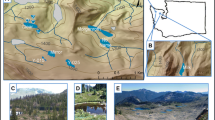ABSTRACT
A whole-lake manipulation of food-web structure (introduction of a top predator, northern pike, to a minnow-dominated lake) was performed in a Canadian Shield lake (L110) to examine the stoichiometric consequences of changes in planktonic community structure generated by altered food-web structure. Minnow abundance, zooplankton biomass and community composition, microconsumer abundance, and concentration and carbon–phosphorus (C:P) ratio of suspended particulate matter were monitored in L110 and unmanipulated L240 before (1992) and after (1993–95) pike introduction. Algal biomass in L110 determined from microscopic examination for postmanipulation and premanipulation periods was also compared with dynamics in a suite of unmanipulated reference lakes from long-term monitoring records. Pike were added in spring in 1993 and 1994 in sufficient quantity to raise pike biomass to levels of around 22 kg ha− 1 by 1994. Minnow populations in L110 responded dramatically, decreasing to levels 30% (1993), 10% (1994), and less than 1% (1995) of premanipulation values. However, most components lower in the food web did not respond in a manner consistent with predictions of existing food-web theory, such as the idea of cascading trophic interactions (CTI). While Daphnia biomass increased in L110 in the first year following manipulation, consistent with CTI, this effect was temporary and Daphnia collapsed in 1995, the year of lowest minnow abundance. Total zooplankton biomass in both lakes declined during the study period and, contrary to CTI, this decline appeared somewhat stronger in L110 than in L240. Dominant microconsumers (heterotrophic microflagellates) did not differ among years in either lake and did not appear to respond to food-web manipulation. At the bottom of the food web, no changes in bacterial biomass occurred in either lake. However, total concentrations of particulate matter appeared to increase in L110 after manipulation (contrary to expectations based on the theory of CTI) while algal biomass did not change in the manipulated lake relative to reference systems. Finally, particulate C:P increased in both L110 and L240 during the study period. The lack of strong response of Daphnia, the lack of response of the microbial food web, decreases in zooplankton biomass and increases in particulate biomass following reduction of minnow populations after piscivore introduction are at odds with expectations from existing food-web theory, such as the idea of CTI as currently formulated. However, the extremely high C:P ratios in particulate matter at the base of the food webs in these lakes, the coincidence of zooplankton declines and increases in particulate C:P ratios, and the results of small-scale mesocosm food-quality experiments are consistent with a hypothesis of a stoichiometric constraint operating on food-web dynamics in this and similar ecosystems.
Similar content being viewed by others
Author information
Authors and Affiliations
Additional information
Received 22 April 1997; accepted 8 July 1997.
Rights and permissions
About this article
Cite this article
Elser, J., Chrzanowski, T., Sterner, R. et al. Stoichiometric Constraints on Food-Web Dynamics: A Whole-Lake Experiment on the Canadian Shield. Ecosystems 1, 120–136 (1998). https://doi.org/10.1007/s100219900009
Issue Date:
DOI: https://doi.org/10.1007/s100219900009




